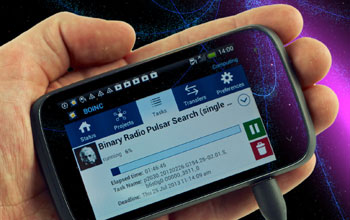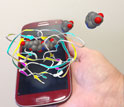News Release 13-130
Smartphones Become Even Smarter
The world's 900 million Android devices may now contribute to world-class research and discovery

Android-based smartphone users can now reach for the stars and discover new radio pulsars.
July 22, 2013
This material is available primarily for archival purposes. Telephone numbers or other contact information may be out of date; please see current contact information at media contacts.
With funding from the National Science Foundation (NSF), the University of California, Berkeley (UC Berkeley) recently developed software that provides new opportunities for Android-based smartphone users to participate in citizen science efforts.
The newly-updated software, called Berkeley Open Infrastructure for Network Computing or "BOINC," gives owners of devices that use Android 2.3 operating systems or higher the chance to participate in volunteer distributive computing--that is, donate the excess computing power of their handheld devices to science.
Increasingly, the idle computers of ordinary citizens have become useful scientific tools. Citizens have donated time from their home and office computers, essentially creating very powerful, globally-distributed supercomputers. Scientists use this computational power to conduct sophisticated simulations and data analyses that often yield discoveries.
More recently, as mobile devices such as smartphones and tablets have become more powerful, energy efficient and numerous, their excess computing power became just as attractive a resource to scientists. There are now about 900 million Android devices, and their total computing power exceeds that of the largest conventional supercomputers.
Volunteer distributed computing enables people and organizations to contribute toward scientific progress with little effort, and is increasing in popularity in a wide range of disciplines such as astronomy, physics, environmental sciences and social sciences.
With the additional processing power from smartphones, researchers from Einstein@Home and IBM's World Community Grid can accelerate their search for astronomical phenomena and medical cures.
Einstein@Home, with funding from NSF and the The Max Planck Institute for Gravitational Physics in Hannover, Germany, leads the search for radio pulsars. The project analyzes large amounts of data from the Laser Interferometer Gravitational Wave Observatory (LIGO) and the Arecibo Observatory in Puerto Rico, the world's largest and most sensitive single-dish radio telescope whose main purpose is to discover radio pulsars, rotating neutron stars that emit beams of electromagnetic radiation.
"Widening the doors to participation in Einstein@Home is great news for astronomy and physics," said NSF Program Director Bogdan Mihaila. "The study of exotic celestial bodies provides unique insights into the behavior of matter at extreme pressures and densities and may shed light on the nature of gravity. Einstein@home allows 'citizen scientists' to make contributions to profound, cutting-edge scientific research."
Three years ago, with data from Arecibo, the first significant discovery through Einstein@Home was made when citizen scientists discovered a rotating pulsar. To date, more than 340,000 participants globally have helped discover almost 50 new radio pulsars. Today, some 900 million Android users in America may easily download an application and contribute their computational power to the effort.
Another project enabled for Android smartphones and tablets is FightAIDS@Home, a search for more effective AIDS treatment hosted on IBM's World Community Grid. The Olson Laboratory at the Scripps Research Institute in La Jolla, Calif., is using computational methods to identify new candidate drugs that have the right shape and chemical characteristics to block HIV protease, HIV integrase, or HIV reverse transcriptase, the three enzymes that the deadly AIDS virus needs to function and spread.
IBM's World Community Grid plans on Android-enabling other projects in the future. IBM's World Community Grid has been used to facilitate research into clean energy, clean water and healthy foodstuffs, as well as cures for cancer, malaria and other diseases.
The BOINC project, which choreographs the technical aspects of volunteer computing, was founded in 2002 at UC Berkeley with support from NSF. Development of its Android version was funded in part by the Max Planck Institute for Gravitational Physics, IBM World Community Grid, NSF and Google.
Einstein@Home was founded as a key project of the World Year of Physics activities in 2005 and was an International Year of Astronomy 2009 project. Einstein@Home is led by the Center for Gravitation and Cosmology at the University of Wisconsin-Milwaukee and the Max Planck Institute for Gravitational Physics in Hannover, Germany, with financial support from NSF and the Max Planck Society. The long-term goal of Einstein@Home is the direct detection of gravitational waves from rapidly rotating neutron stars. Gravitational waves were predicted by Albert Einstein in 1916, but only now is technology catching up: soon scientists will be able to measure these tiny ripples in space-time.
More than 2.3 million computers used by more than 600,000 people and institutions from 80 countries have contributed power for projects on World Community Grid. The result is one of the fastest virtual supercomputers on the planet, advancing scientific work by hundreds of years. By 2013, at least 22 projects were running or had been completed as part of World Community Grid. Since its inception in 2004, this resource created and managed by IBM has provided research scientists with the equivalent of more than 750,000 years of computing at no cost to them.
-NSF-
-
Another project enabled for Android smartphones and tablets is FightAIDS@Home.
Credit and Larger Version -
Einstein@Home analyzes data from the Arecibo Observatory in Puerto Rico to search for pulsars.
Credit and Larger Version
Media Contacts
Ari Fishkind, IBM, (914) 499-6420, email: fishkind@us.ibm.com
Lisa-Joy Zgorski, NSF, (703) 292-8311, email: lisajoy@nsf.gov
Robert Sanders, UC Berkeley, (510) 643-6998, email: rlsanders@berkeley.edu
Mika Elizabeth Ono, The Scripps Research Institute, (858) 784-2052, email: mikaono@scripps.edu
Greg Walz-Chojnacki, University of Wisconsin–Milwaukee, (414) 229-4454, email: gwc@uwm.edu
Benjamin Knispel, Max Planck Institute for Gravitational Physics, +49-511-762-19104, email: benjamin.knispel@aei.mpg.de
Program Contacts
Bogdan Mihaila, NSF, (703) 292-8235, email: bmihaila@nsf.gov
Principal Investigators
Bruce Allen, Max Planck Institute for Gravitational Physics / University of Wisconsin - Milwaukee, email: bruce.allen@aei.mpg.de
Related Websites
BOINC: http://boinc.berkeley.edu/
Einstein@Home: http://einstein.phys.uwm.edu/
Get the BOINC Android app: http://bit.ly/191Of2g
Fight Aids@Home: http://fightaidsathome.scripps.edu/
IBM's World Community Grid: http://www.worldcommunitygrid.org
BOINC for Android FAQ: http://boinc.berkeley.edu/wiki/Android_FAQ
Max Planck Institute for Gravitational Physics: http://www.aei.mpg.de/
Award Abstract to develop BOINC for the use of Einstein@Home: http://www.nsf.gov/awardsearch/showAward?AWD_ID=1104902&HistoricalAwards=false
Citizen Scientists Discover Rotating Pulsar: Einstein@Home project uses data from Arecibo, the world's largest and most sensitive radio telescope: http://www.nsf.gov/news/news_summ.jsp?cntn_id=117500
The U.S. National Science Foundation propels the nation forward by advancing fundamental research in all fields of science and engineering. NSF supports research and people by providing facilities, instruments and funding to support their ingenuity and sustain the U.S. as a global leader in research and innovation. With a fiscal year 2023 budget of $9.5 billion, NSF funds reach all 50 states through grants to nearly 2,000 colleges, universities and institutions. Each year, NSF receives more than 40,000 competitive proposals and makes about 11,000 new awards. Those awards include support for cooperative research with industry, Arctic and Antarctic research and operations, and U.S. participation in international scientific efforts.
Connect with us online
NSF website: nsf.gov
NSF News: nsf.gov/news
For News Media: nsf.gov/news/newsroom
Statistics: nsf.gov/statistics/
Awards database: nsf.gov/awardsearch/
Follow us on social
Twitter: twitter.com/NSF
Facebook: facebook.com/US.NSF
Instagram: instagram.com/nsfgov




